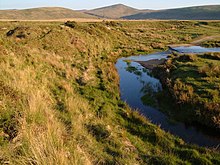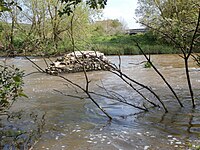River Taw
| Taw | |
|---|---|
 | |
 | |
| Location | |
| Country | England |
| Counties | Devon |
| Towns/Villages | Belstone,Sticklepath,Eggesford,King's Nympton,Umberleigh,Chapelton,Bishop's Tawton,Barnstaple,North Tawton |
| Physical characteristics | |
| Source | Taw Head |
| • location | Dartmoor |
| Mouth | |
• location | Barnstaple / Bideford Bay |
• coordinates | 51°05′N4°13′W/ 51.083°N 4.217°W |
| Length | 72.4 km (45.0 mi) |


TheRiver Taw(/tɔː/) in England rises at Taw Head, a spring on the central northern flanks ofDartmoor,crosses NorthDevonand at the town ofBarnstaple,formerly a significant port, empties intoBideford Bayin theBristol Channel,having formed a large estuary of wide meanders which at its western end is the estuary of theRiver Torridge.
Course
[edit]As a stream, the Taw heads north and gives its name to the villages ofSouth TawtonandNorth Tawton[n 1][n 2].[1]Headwaters add to the size from a number of two major upper course tributaries including theLapford YeoandLittle Dart River.Along the middle course the Taw receives theRiver Mole(distributaryof theRiver Brayand a second Yeo)[n 3],which all rise on uplandExmoorto the north-east. By this midway stage the river has increased in size and becomes a season-round recreational trout, sea trout and salmon river before becoming tidal atNewbridge,approximately 19 km (12 mi) from the sea. The river drains a variable width basin as one of many rivers in the strongly agricultural county, the river has a rolling valley surrounded by (in order of frequency of occurrence) animalpasture,cultivated fields and woodland until near its end. Its length is approximately 72 km (45 mi).
TheTarka Trailnamed afterTarka the Otterfollows much of the river's course.[2]
In 1604, the activity of timber merchants and carpenters who floated timber on the river to Barnstaple angered the landowners, the Earls ofBedfordandBath.The timber damaged banks made to protect marshy ground from flooding.[3]
List of bridges
[edit]The following is a list of bridges over the River Taw listed going upstream from the estuary at Barnstaple. The left bank of a river is that on the left of a traveller progressing downstream.
| Bridge | Photo | Date Opened | Left bank | Right bank |
|---|---|---|---|---|
| Taw Bridge (Barnstaple Western BypassBridge) |  |
May 2007 | Tawstock/Fremington | Pilton |
| Barnstaple Long Bridge |  |
Medieval | Sticklepath/Tawstock | Barnstaple |
| Barnstaple Long Bridge is of medieval origin, but has been widened on various occasions by adding width to the upstream side. | ||||
| Rumsam Bridge |  |
1989 | Tawstock | Rumsam/Bishops Tawton |
| Rumsam Bridge carries the main A39 road between Barnstaple and Bideford, crossing the Taw approximately between Barnstaple and Bishops Tawton | ||||
| New Bridge |  |
Early 19th century[4] | Tawstock | Bishops Tawton |
| South of Bishops Tawton. A bridge of medieval origin.Bishop of ExeterWalter de Stapledon(1261–1326) ofAnnery, Monkleighbequeathed in his will dated 1326 the sum of 60 shillings for its repair. The present structure probably dates from the early 19th century. A ruined pier of an earlier bridge is visible in mid-stream 140 yards downstream.[5](see below) | ||||
| Medieval New Bridge |  |
Medieval | Tawstock | Bishops Tawton |
| A ruined pier of the medieval New Bridge, in mid-stream 140 yards downstream of the 19th-century New Bridge[6] | ||||
| UmberleighBridge |  |
Rebuilt 1914-15 | Atherington | Chittlehampton |
| Stone tablet on left bank downstream parapet inscribed:Devon County Council. Umberleigh Bridge. Rebuilt 1914-15.... M. Stead, R.M. Stone, County Surveyors; C. Pollard & Co Ltd, contractors | ||||
Tidal section
[edit]The river shares the large tidal ranges of theBristol Channeland daily changes of water depth of 6 m to 8 m are common near its mouth. This effect can also be seen in changes to the tidal-estuarine basin, which is 18 km long. The tidally-influenced river starts atNewbridge,4 km south of Barnstaple, where the river's width is approximately 20 m. The channel's width increases dramatically over the next 8 km, reaching 1 km byFremington.
At Barnstaple the Taw is joined by the(Barnstaple) Yeo,which is tidal for a short distance inland. Seawards of Fremington, the smallRiver Caenjoins the river on its north bank, the river ofBraunton.This tributary was made navigable on its main lower course as theBraunton Canalin the early 19th century.
River legacy
[edit]The Taw also gives its name toBishop's Tawtonjust before passing through the only town on its route,Barnstaple.The Long Bridge here, originally medieval, is the second-lowest bridging point of the Taw. Work finished in 2007 on the long-awaited 'downstream bridge', part of theBarnstaple Western Bypassand now the Taw's lowest crossing point; it was opened in May 2007. Seawards of Barnstaple, the river's journey is blocked by the largedunecomplex ofBraunton Burrows,hence its late diversion south-westward and shared estuary mouth with theRiver TorridgeacrossZulu Barsandbanks and out intoBarnstaple (or Bideford) Bay.
The second lowest port on the Taw is Fremington. Between the mid-19th and mid-20th centuries its tidal quay was the busiest port (tonnage) between Bristol and Lands End, mainly as it was a handy landing point for Welsh coal shipped across the Bristol Channel which could be distributed around the south-west peninsula by train (track finally closed 1987). The lowest port (or at least jetty) can be found atYelland.The site of acoal-fired power station(closed 1984; demolished 1989), it still is used as a tanker-distribution centre for commercial and domestic petrol and diesel deliveries. The oil storage tanks here are filled from coastal lighters.
Flooding
[edit]The flooding of the Taw in August 1983 and the destruction of the sand dune causeway toCrow Islandat the southern tip of Braunton Burrows was the inspiration for Ted Hughes' poem to commemorate the christening ofPrince William,son ofKing Charles III- Rain-Charm for the Duchy.
Rail links
[edit]Localrailandroadroutes follow the river from Barnstaple through the centre of the county.
TheSouthern Railwaybuilt a series of 4-6-2 steam locomotives named after various places within theWest Country.Thelocomotive that honours the Taw Valleyis preserved in its rebuilt form on theSevern Valley Railwaycarrying its post-nationalisation number 34027.
External links
[edit]- Current river level at Umberleigh
- Webcam view of River Taw running under Barnstaple's Long Bridge
- Tide times and heights for the Taw's mouth
- Environment Agency: Taw and North Devon Streams Catchment Abstraction Management Strategy. Map p.6
- Fishing: River Taw Fisheries Association
Notes and references
[edit]- Notes
- ^Latter life chosen home village of thePoet LaureateTed Hughes
- ^Anciently called Cheping or Chipping Tawton, implying Market Tawton
- ^Sometimes named the "Molland Yeo" to distinguish it from others.
- References
- ^Samuel Lewis, ed. (1848)."Tatchbury - Taynton".A Topographical Dictionary of England.Institute of Historical Research.Retrieved25 December2012.
- ^OpenStreetMap
- ^M. S. Giuseppi,HMC Calendar of the Manuscripts of the Marquess of Salisbury,16 (London, 1933), pp. 362, 403.
- ^Hoskins, W.G.,A New Survey of England: Devon, London, 1959 (first published 1954), p.338
- ^Hoskins, W.G.,A New Survey of England: Devon, London, 1959 (first published 1954), p.338
- ^Hoskins, W.G.,A New Survey of England: Devon, London, 1959 (first published 1954), p.338
